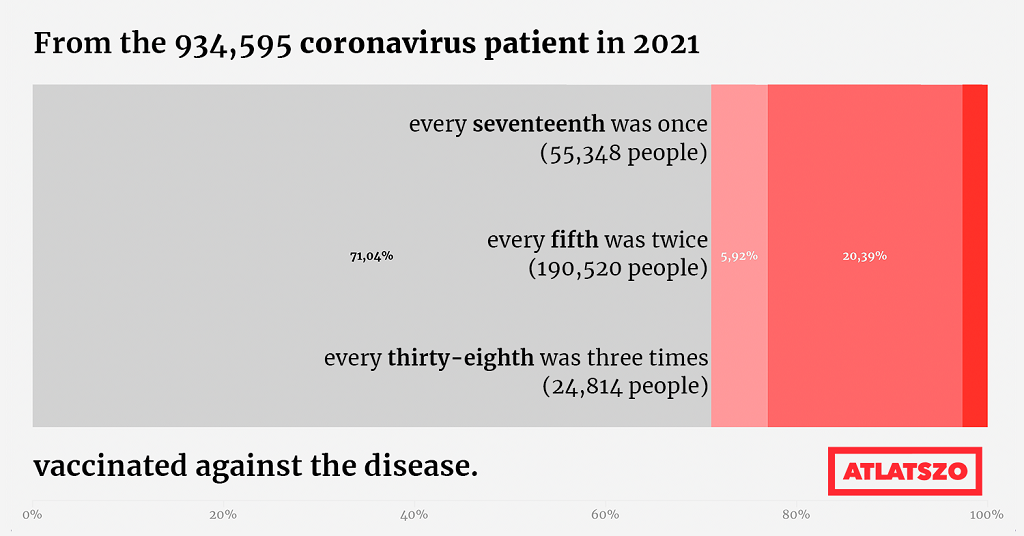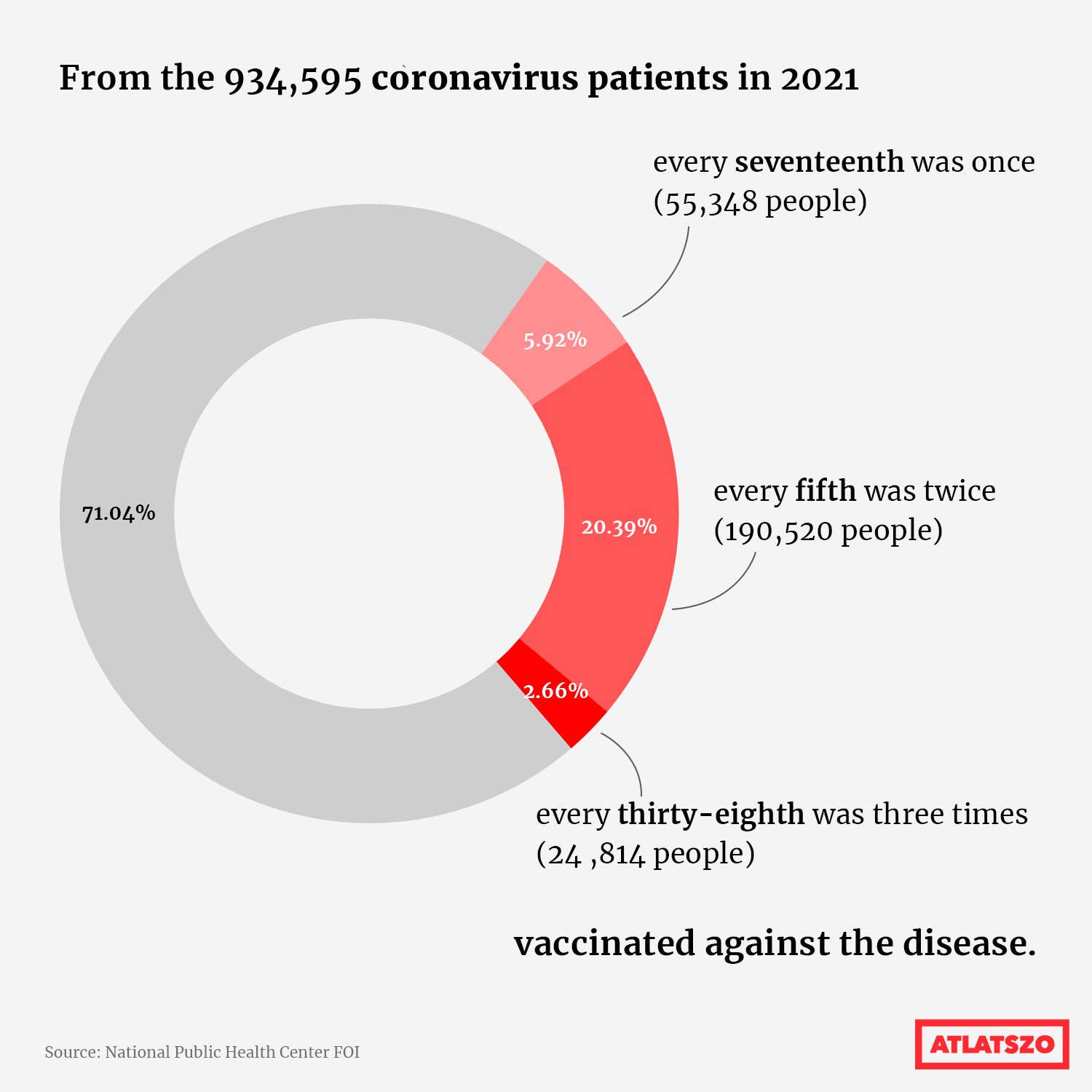The https://english.atlatszo.hu use cookies to track and profile customers such as action tags and pixel tracking on our website to assist our marketing. On our website we use technical, analytical, marketing and preference cookies. These are necessary for our site to work properly and to give us inforamation about how our site is used. See Cookies Policy
Last year, 70 percent of people infected with COVID-19 in Hungary were unvaccinated
We managed to get more information on the spread of the coronavirus pandemic in Hungary. In a FOI request, we asked the National Public Health Centre (NNK), for data on the vaccination history of registered people infected wirh COVID-19. The database now available gives a more accurate picture than ever before of how many people in a given settlement became ill last year and how many of them were vaccinated with one, two or even three doses. The data show that 71% of those infected were unvaccinated.
On 30 June, we submitted a FOI data request to the National Public Health Centre for the vaccination history of registered coronavirus-infected persons in Hungary. We finally received an answer 30 days later: the NNK sent us the number of unvaccinated coronavirus-infected people registered in each settlement for the year 2021, as well the exact number of doses of vaccine received by those vaccinated. However, the type of vaccination and the date of vaccination were not given.

And the the table is incomplete in some places: “in order to avoid the risk of identification, I provide the requested data per municipality for the whole year 2021, assigning the data on the vaccination status of the persons and, in the case of 3 or less cases remaining after that, the numbers are dotted.”*
The majority of infected people have not been vaccinated
According to the official epidemiological information site, koronavirus.gov.hu, there were a total of 931,901 registered coronavirus infections between 1 January and 31 December 2021. The new data set now shows 934,000 infected, a difference of more than 3,000.
In total, there were almost 90 such cases, so we do not have exact information on the exact number of infected people in over 3100 Hungarian settlements, nor do we know how many vaccinations, if any, they received*.
What is clear from the data, is that the vast majority of those infected in 2021 were unvaccinated.
This represents 663,000 of the 934,508 infected.
Of the vaccinated patients, most (roughly 190,000, 20.39%) had received two doses, followed by those who had received only one dose (55,000, 5.92%) at some point prior to infection. The number of people vaccinated three times was the lowest, with only 24,000 people in this category. It is worth adding, however, that the third dose was only available from the second half of last year. By the end of the year, a total of 3.18 million people had taken advantage of the booster vaccine.
These figures cannot be used to draw any precise conclusions, because we do not know exactly when these people were infected and when exactly they were vaccinated.
Without knowing the specific dates, we can only say that nearly 30 percent of those infected in 2021 had been vaccinated at some point, while 70 percent hadn’t.
If we look at the figures by settlements, we see very similar rates to the national level. For example, among the county seats, Kaposvár had the highest proportion of unvaccinated coronavirus infections last year, with 6124 of 7801 infected people not vaccinated. This is a rate of almost 78 percent.
The proportion of those infected who were vaccinated once was also highest in the same city. The proportion of twice-vaccinated infected was highest in Szolnok, Zalaegerszeg and Miskolc, all three municipalities with vaccination rates above 25 percent. The highest proportions of third vaccine recipients were in the capital and Pécs, where 4 percent of all infected people were vaccinated with booster doses.
The highest proportions of patients with at least one vaccine were in Szolnok, Zalaegerszeg, Miskolc and Pécs.
We have also out the data obtained on a searchable map, so that the numbers of a given settlement can be better seen.
The data can also be browsed in the following spreadsheet:
More and more is known about the spread of the pandemic
Since the start of the coronavirus pandemic, we have written many articles about the lack of transparency of official government communication and the impossibility to obtain up-to-date data on the pandemic. Although the epidemic is far from over and the numbers are now rising again, for some reason the NNK is responding to many more of our FOI requests recently.
At the end of May, for example, we received unprecedented detail on how many people had died from the virus in a given settlement on a given day up to the end of January 2022.
Detailed COVID-19 mortality data obtained by Atlatszo raises more questions than it answers
Atlatszo has received more detailed data than ever before from the National Public Health Centre (NNK) on deaths from coronavirus infection. The table shows how many people have died from COVID-19 in a settlement on a given day up to the end of January 2022.
And in our article from early July, we managed to learn more about the vaccination history of the deceased.The data showed that three quarters of the deaths in 2021 were unvaccinated. We also recently found out exactly which vaccinations the deceased received.
Three quarters of those who died from COVID-19 last year in Hungary were unvaccinated
On May 25, 2022, we submitted a FOI request to the National Public Health Center (NNK), in which we wanted to know the vaccination history of those who have died from COVID-19: if the deceased received vaccinations, how many and what type of vaccine.
Written and translated by Zita Szopkó. Data visualisation: Krisztián Szabó. The original, Hungarian version of this story can be found here.
*Methodology: in the table received, for those settlements with three or fewer infected people in 2021, NNK did not include the exact numbers for the columns. In these cases we calculated with only one person to avoid overestimation. In the column of unvaccinated infected, where the number was also dotted, only one person was entered for the missing values. Where there was a value in at least one of the vaccination cells, the number of vaccinated infected was subtracted from the total number of infected and the remaining value (up to a maximum of three) was entered in the unvaccinated infected column. For the number of infected vaccinated once, twice and three times, the missing cells were filled in prioritizing the number of first vaccinated. Because of all this, for the municipalities with 1-3 infected, the numbers validated by the NNK may differ more or less from the database we have extended.



